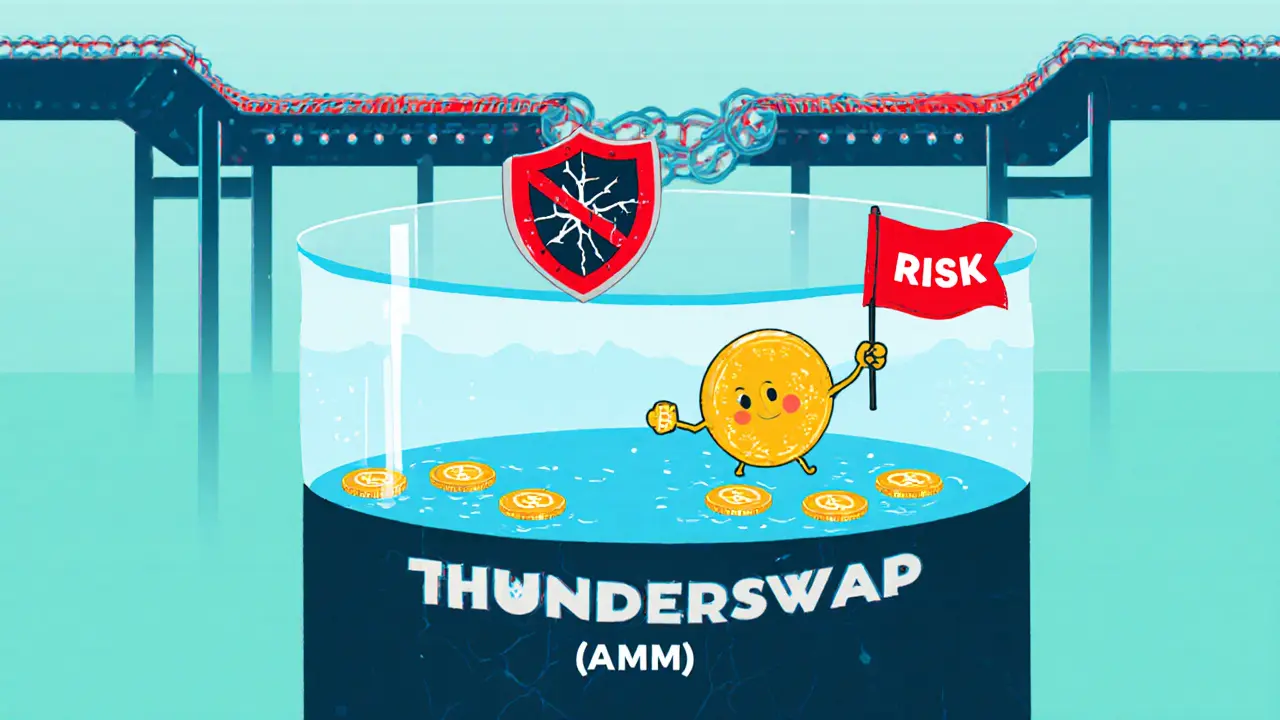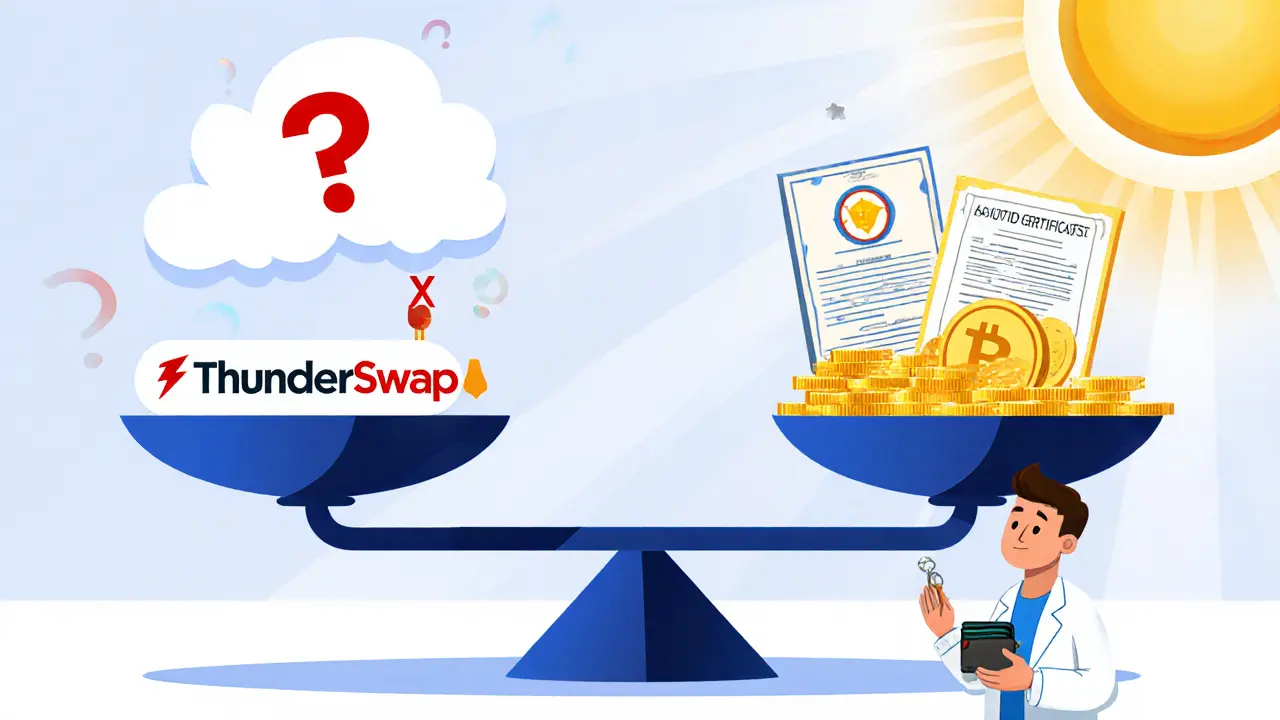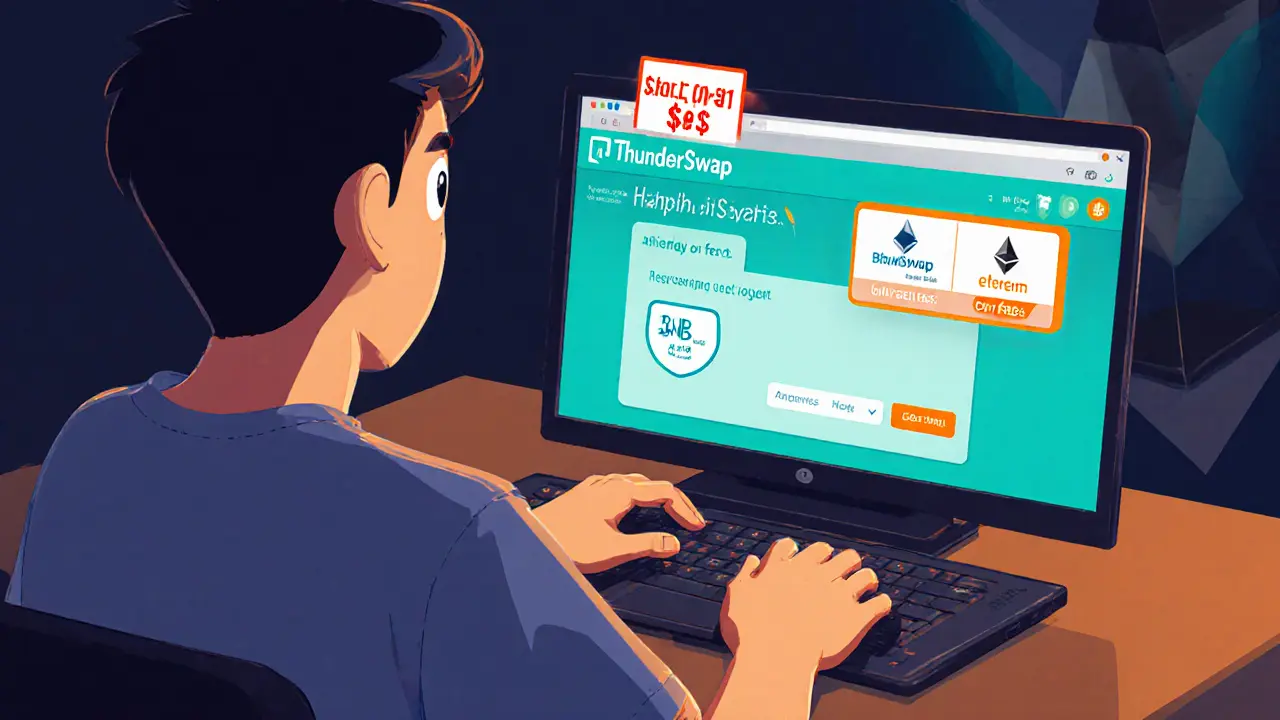ThunderSwap DEX Comparison Tool
ThunderSwap Overview
A BSC-based DEX forked from Uniswap with limited transparency and security audits.
High RiskPancakeSwap Overview
Leading BSC DEX with strong liquidity, community, and ecosystem features.
EstablishedKey Metrics Comparison
| Feature | ThunderSwap | PancakeSwap | Uniswap |
|---|---|---|---|
| Network | BSC | BSC | Ethereum |
| TVL (2025) | Not tracked | $2B+ | $6B+ |
| Base Fee | ~0.25% | 0.20% | 0.30% |
| Security Audits | None | Yes | Yes |
| Community Activity | None | High | High |
| Regulatory Compliance | Unknown | Partial | Partial |
Risk Assessment
High Risk Factors
- No verifiable TVL
- No security audits
- No community presence
- Missing compliance info
Moderate Features
- Low BSC fees
- Simple interface
- TNDR governance
Recommended Alternatives
- PancakeSwap
- Uniswap
- SushiSwap
Recommendation Summary
Based on the data reviewed, ThunderSwap is not recommended for regular trading due to:
- Missing key metrics (TVL, volume)
- Lack of security audits
- No active community or development
- Unclear regulatory stance
For safer and more transparent trading experiences, consider established platforms like PancakeSwap or Uniswap.
When you hear the name ThunderSwap is a decentralized exchange (DEX) forked from Uniswap and operating on the Binance Smart Chain (BSC), the first question is whether it actually delivers on the promises of low fees and fast swaps. This ThunderSwap review pulls together the scarce data that exists, compares the platform to the market leaders, and tells you if you should even bother connecting your wallet.
What is ThunderSwap?
ThunderSwap launched as a direct copy of Uniswap’s original Automated Market Maker (AMM) model, but moved the contracts to Binance Smart Chain (BSC) to take advantage of lower gas costs. The platform’s native token is TNDR, symbol TNDR, which is listed on a few niche exchanges such as WEEX. Unlike big‑name DEXs, ThunderSwap does not publish a whitepaper, audit reports, or a public road‑map, leaving potential users in the dark about development activity.
How the AMM Works on ThunderSwap
At its core, ThunderSwap uses the classic constant‑product formula x×y=k that powers Uniswap V1. Liquidity providers (LPs) deposit equal values of two tokens into a pool, and traders trade against that pool. Because the contracts live on BSC, each transaction typically costs less than $0.01 in BNB, a stark contrast to Ethereum’s $5‑$15 gas fees during peak periods. However, the platform does not implement the newer concentrated‑liquidity features found in Uniswap V3, nor does it have stable‑coin‑optimised curves like Curve.
TNDR Tokenomics
The TNDR token (TNDR) serves three primary purposes: governance, fee rebates, and incentivising liquidity. Official numbers are vague, but community‑sourced data suggests a total supply of 500million TNDR, with roughly 30% allocated to the founding team. No lock‑up schedule or audit of the token contract is publicly available, so investors cannot verify whether the supply is truly capped.

Security & Audits - What’s Missing?
One red flag for any DeFi project is the absence of third‑party audits. A search of reputable audit firms (Hacken, CertiK, Quantstamp) returns no report for ThunderSwap’s contracts. The platform also lacks a bug‑bounty program and does not publish security‑related blog posts. In an ecosystem where exploits routinely cost users millions, the missing audit raises legitimate concerns about smart‑contract vulnerabilities.
Market Presence, Liquidity & Volume Tracking
Unlike PancakeSwap, which boasted over $2billion total value locked (TVL) in early 2025, ThunderSwap’s on‑chain metrics are effectively invisible. CoinMarketCap lists the exchange as a “non‑tracked” project, explicitly stating that volume data is not monitored. Without TVL or daily trade volume numbers, traders cannot gauge slippage risk or assess whether the pool depth is sufficient for meaningful swaps.
Regulatory Landscape - MiCA’s Impact
In the European Union, the Markets in Crypto‑Assets (MiCA) regulation came into force in June 2024, obliging trading platforms to implement robust transaction monitoring and KYC measures. As a decentralized protocol, ThunderSwap does not collect user data, but MiCA’s broader compliance expectations have pressured many DEXs to improve transparency or risk being blacklisted by fiat‑on‑ramp providers. ThunderSwap’s lack of any compliance documentation suggests it may struggle to attract institutional users under the new rules.
User Experience & Community
Typical DEX onboarding involves connecting a wallet (MetaMask, Trust Wallet), approving BNB for gas, setting slippage tolerance, and confirming the swap. ThunderSwap’s UI mirrors this flow but is hosted on a domain that often redirects to a placeholder page, and the community presence is near‑nonexistent. A scan of major forums-Reddit’s r/CryptoCurrency, r/defi, Trustpilot-yields zero user reviews. In contrast, Uniswap enjoys thousands of daily active users and a vibrant Discord, while PancakeSwap maintains over 1.5million Twitter followers.

Side‑by‑Side Comparison
| Exchange | Network | TVL (2025) | Base fee | Key features |
|---|---|---|---|---|
| ThunderSwap | BSC | Not tracked / unavailable | ~0.25% (claimed) | Simple AMM, TNDR governance token |
| PancakeSwap | BSC | $2B+ | 0.20% swap + 0.10% LP fee | Farms, lottery, IFOs, advanced UI |
| Uniswap | Ethereum | $6B+ | 0.30% (standard V2), V3 adds 0.05‑0.30% range | Concentrated liquidity, V3 routing, robust dev ecosystem |
Pros and Cons Quick Checklist
- Pros
- Low‑cost BSC transaction fees
- Simple Uniswap‑style interface for beginners
- Potential governance opportunities via TNDR
- Cons
- No verifiable TVL or trading volume
- Zero third‑party audit - higher smart‑contract risk
- Virtually no community or developer activity
- Regulatory opacity under MiCA and similar frameworks
Final Verdict - Should You Use ThunderSwap?
For most traders, the answer is a firm “no.” The platform’s lack of transparent liquidity, missing security audits, and nonexistent community make it a high‑risk environment. If you are an experimental developer looking to test a thin AMM on BSC without moving large amounts of capital, you might connect a wallet just to explore the UI. Otherwise, established DEXs like PancakeSwap or Uniswap provide far better liquidity, audited contracts, and active support.
Frequently Asked Questions
Is ThunderSwap still operational in 2025?
There is no public evidence of recent development activity, and the exchange does not appear on major DEX aggregators. While the smart contracts still exist on BSC, the UI often redirects to a placeholder, suggesting the platform is effectively dormant.
What fees does ThunderSwap charge?
The site claims a base fee of about 0.25% per swap, slightly lower than Uniswap’s 0.30% but higher than PancakeSwap’s 0.20%. Because no audit confirms the contract code, the exact fee structure cannot be verified.
How can I earn TNDR tokens?
TNDR is distributed primarily to liquidity providers and through occasional governance proposals. The platform does not publish a clear emission schedule, so prospective earners should treat the token as speculative.
Is ThunderSwap safe to use without a KYC process?
As a decentralized protocol, ThunderSwap does not require KYC. However, the lack of audits and transparent metrics means the safety of your funds relies entirely on the underlying smart‑contract code, which is unverified.
Should I trust a DEX that is not listed on CoinGecko or CoinMarketCap?
Generally, reputable DEXs appear on major analytics sites because they meet data‑transparency standards. If a platform is absent, it’s a warning sign that liquidity, volume, or even the code may be hidden.


Hanna Regehr
ThunderSwap’s fee claim of roughly 0.25% looks attractive on paper, but without audited contracts you can’t be sure the fee split isn’t favoring the developers. The lack of TVL data makes it impossible to gauge slippage risk, especially for larger trades. If you’re just testing the UI with a fraction of a BNB, it might be fine, but moving real capital should be avoided until transparency improves. Also, the TNDR token has an opaque supply, which adds another layer of risk for speculative holders.